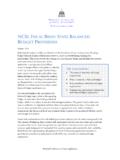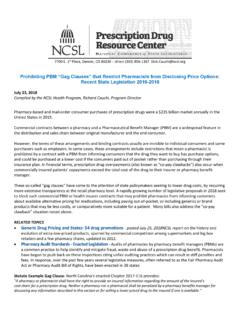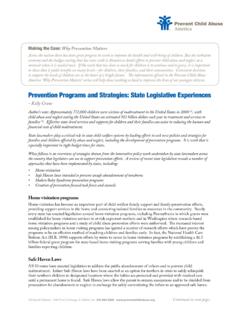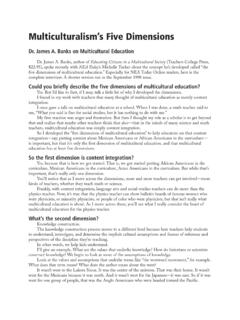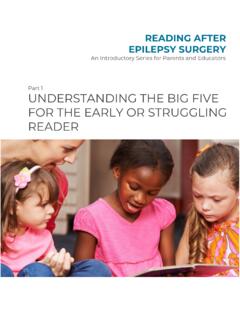Transcription of The Social and Emotional Well-Being of Children in Foster Care
1 The Social and Emotional Well-Being of Children in Foster care By Nina Williams-Mbengue A. Introduction Just over 415,000 Children and youth in the currently reside in Foster care . While this number is high, it represents a significant decline in Foster care placements over the past decade, with the number of Children in Foster care decreasing by almost a quarter between 2002 and A federal and state-level focus on the safety and permanency of Children in care has been an important factor contributing to the decline in caseloads. Despite such progress, state child welfare systems continue to struggle with the Social and Emotional Well-Being of Children in care , particularly for Children with complex behavioral and mental health Definition of Child Well-Being . Child Well-Being is described by the federal Administration for Children , Youth and Families in its April 2012 Information Memorandum (ACYF-CB-IM-12-04) as.
2 Children s behavioral, Emotional and Social functioning those skills, capacities and characteristics that enable young people to understand and navigate their world in healthy, positive ways. 3 The administration has further identified four primary domains for measuring Well-Being : cognitive functioning, physical health and development, behavioral/ Emotional function and Social functioning. Child Well-Being is an important focus for states because of its lifelong impact on Children and their success as productive adults. State policymakers now understand that Children and youth in Foster care face long-term risks from their exposure to violence, child maltreatment and other adverse childhood experiences and are anxious to identify and implement strategies that will minimize the long term consequences for Children and the costs to state budgets. Fortunately, there is also an increasing body of evidence-based programs that state child welfare systems can develop to significantly improve Children s Well-Being .
3 This extended edition newsletter focuses on the Social and Emotional Well-Being of Children and youth in Foster care . The newsletter will provide information on the Social and Emotional characteristics and needs of Children in care , discuss the impact of child maltreatment and trauma on Children s development and examine state and local policies and practices to address the Well-Being of Children in Foster care . Additionally, the legislative role in improving child Well-Being will be considered. B. Why is the Social and Emotional Well-Being of Children in Foster care at Risk? The Social and Emotional Well-Being of Children in Foster care is jeopardized by the conditions that lead to their removal from home, as well as their experiences once in care . While the number of Children in placement has been reduced in the last decade from more than 511,000 in 2005 to 415,000 in 2014, little data exists about the Well-Being of Children in Additionally, effective indicators of Well-Being have not been identified or measured routinely.
4 The Well-Being of Children Who Enter Foster care Children who are placed in Foster care for their protection have experienced many conditions that may threaten their safety and Well-Being . As the table below indicates, the majority of Children who are confirmed for child maltreatment are victims of neglect. Though defined differently from state to state, neglect is often a complex combination of conditions that may include: 5 Physical neglect, such as abandonment or failure to provide for a child s nutritional or other physical needs. Inadequate supervision, such as exposure to hazards or lack of appropriate caregivers; Medical neglect through denial or delay of health care . Emotional neglect, such as inadequate nurturing or affection, Social isolation, chronic or extreme spouse abuse. Neglect of a child s educational needs. Newborns addicted or exposed to drugs.
5 After child neglect, the most common reason for removal is parental substance abuse. Other removal reasons include caretaker inability to cope, child behavior, physical abuse, and other conditions that make a child vulnerable and that may impact the child s Well-Being . In addition to abuse and neglect, Children who enter Foster care may have been exposed to parental substance abuse, domestic and community violence and poverty. The Impact of a Child s Experiences While in Foster care The removal from home can be devastating and confusing for Children . Once in Foster care , Children may experience prolonged stays in care . According to 2014 AFCARS data, of the 238,230 Children who exited Foster care in Fiscal Year 2014, 53 percent had been in care 12 months or Children s Length of Stay in Foster care in Fiscal Year 2014 Number of Children Percent in care Length of Stay in care 94,358 23% 1 - 5 Months 83,978 20% 6 11 Months 62,447 15% 12 17 Months 39,620 10% 18 23 Months 29,401 7% 24 29 Months 18,833 5% 30 35 Months 36,292 9% 3 4 Years 28,058 7% 5 Years or More The longer a child is in placement, the greater the chance that he or she will move from one Foster placement to another, placing the child at further risk of negative Social and Emotional outcomes.
6 7,8 Frequent moves mean that the child faces continuing disruption of relationships with friends, siblings and other relatives, coaches, teachers, classmates, religious leaders and others. Children may move from their original schools multiple times during the school year. Frequent changes in caseworkers, judges and legal representation also interfere with child Well-Being and achievement of a permanent home. 9 The Behavioral and Mental Health Needs of Children in Foster care Recent research from the National Survey of Child and Adolescent Well-Being finds that Children and youth in Foster care have high levels of mental health needs and that those needs are not being met. Children and youth in Foster care with mental health disorders stay in Foster care longer, rely more on expensive residential treatment placement, experience more moves in care , have higher involvement with the criminal justice system and have poorer educational Eighty percent of youth involved with the child welfare system require mental health intervention and services due to developmental, behavioral or Emotional Children in Foster care utilize mental health services at five to eight times the rate of other Medicaid-eligible Children and youth in residential treatment centers (the majority of whom come from the child welfare system)
7 Have higher rates of mental and behavioral health disorders than Children in the general Children in Foster care are more likely to use multiple psychotropic medications than Children that are not in the child welfare Compared to other Medicaid-eligible youth, Children in Foster care have two to eight times the rates of various psychiatric medication Impact of Trauma It is estimated that 90 percent of Children in Foster care have been exposed to A comprehensive review of Children entering Foster care in one state revealed that one in four exhibited trauma symptoms requiring The term complex trauma describes Children 's exposure to multiple or prolonged traumatic events, which are often invasive and interpersonal in nature. Complex trauma exposure involves the simultaneous or sequential occurrence of child maltreatment, including psychological maltreatment, neglect, exposure to violence and physical and sexual abuse.
8 Trauma can be compounded by the removal of Children from their families, loved ones, and communities and by adverse experiences in Foster care . A growing body of research reveals negative long-term consequences of traumatic stress, especially repeated exposure to trauma such as might be experienced by Children who have been abused or neglected, on physical, cognitive, Social and Emotional functioning. 18 Children s relationships and attachments to caretakers can be affected, further exacerbating difficulties they may experience in Foster care . Into adulthood, Children and youth who have undergone traumatic experiences may have problems ranging from depression and addiction to cancer, diabetes and heart C. The Costs of Poor Social and Emotional Well-Being The Social and Emotional Well-Being of Children who enter Foster care has tremendous consequences both on the course of their lives and on the long term costs to taxpayers.
9 The total annual cost of child abuse and neglect in the in 2012 has been estimated to be $ billion. The Pew Center on the States estimates the costs to society to pay for medical and mental health services annually is more than $30,000 for each abused For Children in Foster care , mental health expenditures are 8 to times greater than the expenditures for other Medicaid eligible In addition to Medicaid costs for direct health services of Children in Foster care , such as in-patient treatment or dental services, states spend more than $1 billion in Medicaid for child welfare services. Of the 39 states that responded to a recent survey of FY2010 state child welfare expenditures, 27 reported that the number one use of Medicaid dollars by child welfare systems was for rehabilitative services such as residential and behavioral modification treatment, followed by targeted case management and therapeutic Foster care .
10 22 Recent research also shows that multiple, negative events in childhood, such as those experienced by many Children in Foster care , have costly health consequences that can impact state budgets for many years. The Adverse Childhood Experiences Study (ACES) is a longitudinal examination of health outcomes for adults who experienced a variety of multiple, negative events in childhood such as child maltreatment, exposure to domestic violence, living with substance abusing parents, growing up with a growing up with a mentally ill or incarcerated parent or parental abandonment through divorce or death. The study indicates significant effects well into adulthood, including:23 Child Maltreatment Impacts: Brain Function and Structure Neuroscience teaches us that the early experiences of young Children have a tremendous influence on their developing brains. Healthy Emotional and cognitive development is shaped by responsive, dependable interaction with adults, while chronic or extreme adversity, such as extreme poverty, caregiver substance abuse or mental illness, exposure to violence or family hardship without appropriate adult support, can cause excessive amounts of the cortisol hormone to be produced resulting in toxic stress, which disrupts developing brain circuits.
